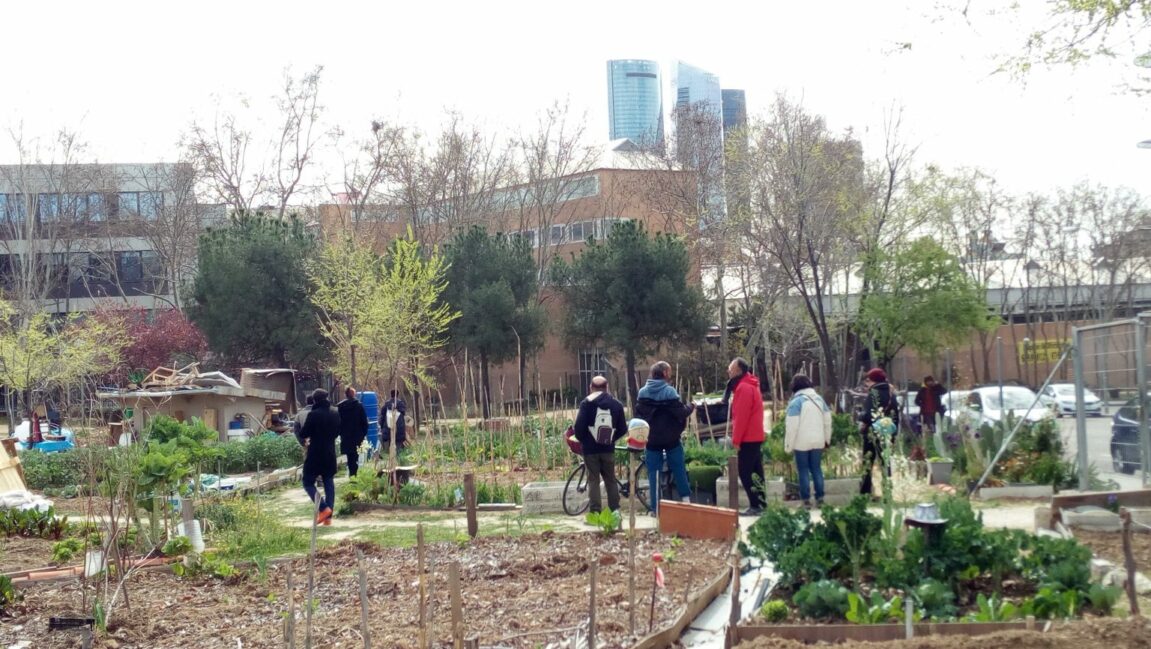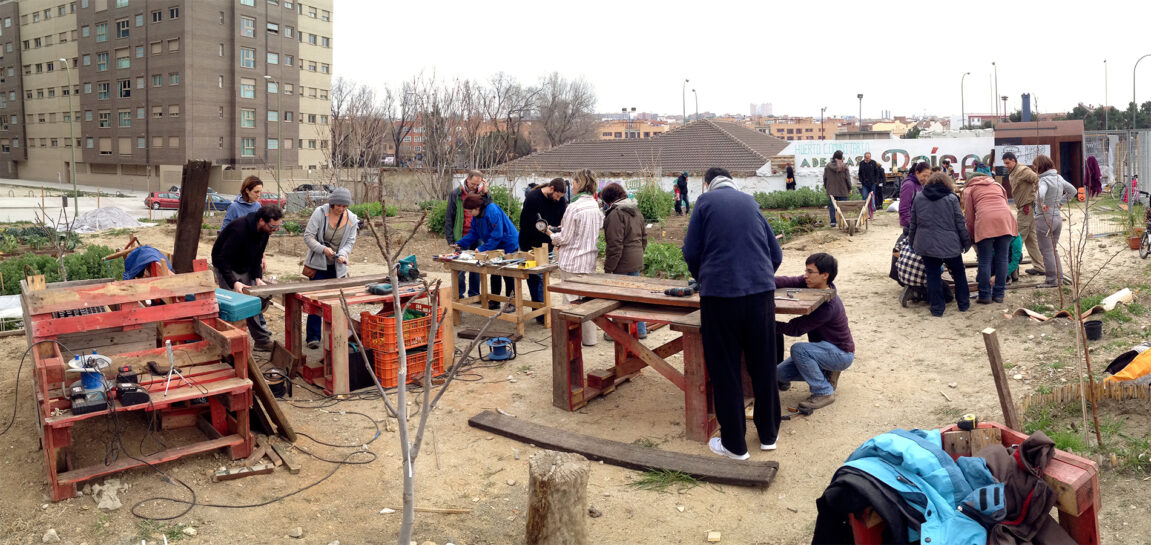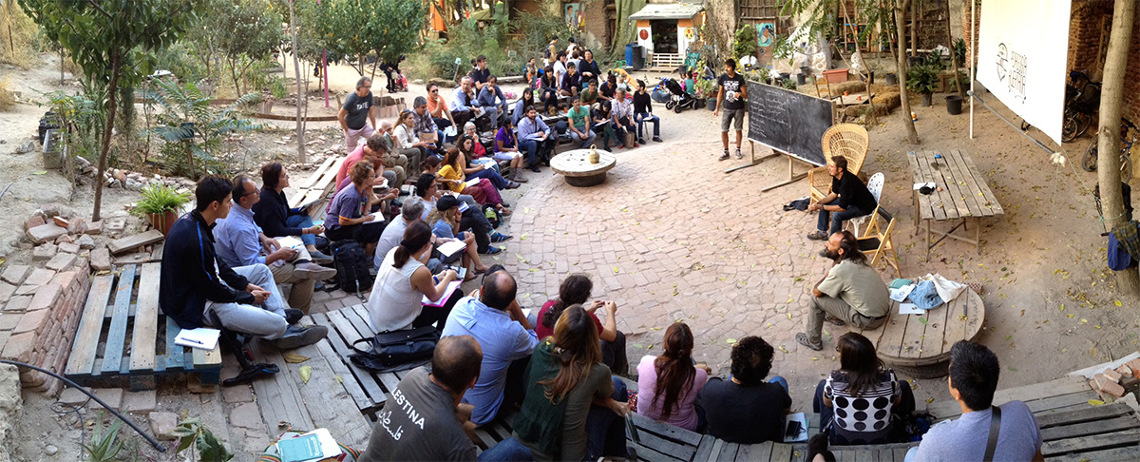Ethnography is formulated here as an infrastructural project, an endeavour whose effort to devise a shared infrastructure composes an ethnographic situation for the anthropologist to relate to his counterparts. The ethnographic infrastructure—as I call it—is not a site of investigation or an object of inquiry, but a sociomaterial assemblage from which ethnographic relations emerge, anthropological problems are defined and the anthropologist’s empirical practice unfolds. Shifting form observational practices, anthropologists engaged in an experimental collaboration with their companions to produce novel problematizations. Such mode of inquiry demands from anthropologists to get a hold of the sociomaterial conditions of ethnography to ‘device’ the possibility to think with their counterparts.
FILE CARD
Fieldwork device: Ethnographic infrastructure.
Mode of inquiry: Experimental collaboration.
Geographical location(s): Madrid (Spain).
Duration / time: 2015 – ongoing (6 years).
Ethnographic counterparts: Professionals, university graduates, urban activists, mainly architects and urban gardeners.
Resources: Funding for the ethnographic companions.
Substantive outputs: http://www.ciudad-escuela.org, http://www.ciudad-huerto.org
Degree of difficulty: Medium.
We met that morning in Fuencarral, a peripheral neighbourhood in the north of Madrid, for the closing activity of an artistic project that we had developed during the previous year—in spite of the pandemic crisis. It explored the wonders and knowledges that were cultivated by neighbours growing small gardens in the interstices of streets, square corners and vacant spaces in that modest neighbourhood. The route was one among the many activities carried out by Ciudad Huerto over the years, an association formed by an architect, three community gardeners and myself in 2015. I was amazed that morning—a tantalizing experience I have had in other occasions—with the unexpected modest marvels and urban creativity that my fellow companions showed us while walking. For almost three hours a large group of forty people—some of them art and cultural professionals coming from different parts of the city—visited half a dozen small informal DIY gardens and talked to their gardeners. While on site, we used headphones to listen to a musical composition that mixed traditional melodies coming from the countries origin to the plants cultivated in each garden. The activity was one of the many we had organized over the previous six years when we had held workshops on auto-construction, mediation, communication, and more theoretical seminars on watering or seeds for community gardens. The displacement that morning to Fuencarral was a common trait for each activity had taken place in any of the many community gardens that had proliferated in the last ten years in the city.
Ciudad Huerto was, as Manuel used to say, a spin-off to Ciudad Escuela (The City as a School) a pedagogic project that was born in 2014 as a result of an experimental collaboration between two urban guerrillas (Basurama and Zuloark) and a couple of anthropologists (myself included) . Madrid was at that time a vibrant city populated by urban interventions (from self-managed spaces to community gardens and neighbourhood initiatives of diverse types) that came after the wave of the 15M movement, Spanish precursor of the Occupy movement. Neighbours of diverse types refurnished the public space with all kind of methodologies and material infrastructures that turned the city into a source of new apprenticeships. In this singular climate, Ciudad Escuela was devised as a pedagogical infrastructure that investigated and instigated these inventive practices: it was aimed at making circulate the many knowledges involved in these interventions. The itinerant condition I have described was fundamental to Ciudad Escuela’s (and Ciudad Huerto) methodology—I will refer to both projects under the rubric Ciudad Escuela from now on. These displacements traced over the years a geographical itinerary that pinpointed those sites where the city was reinvented by neighbours that took a hold of the urban space through small gestures of care and experimentation (that was the saying of Alberto that morning in Fuencarral before starting our dérive). The notion of itinerary was of particular fondness to Ciudad Escuela: The itinerary was a literal displacement and route on the city, but the itinerary was too (and this was indeed its original formulation) a pedagogic program that signalled what we considered relevant practices of urban intervention, as I recount below.
Ciudad Escuela was, in a sense, an art project devoted to cultivating an urban pedagogy, but in another sense, it was an ethnographic situation for me, one that connected to my previous ethnographic project and prolonged it over the city. I am interested here in this second aspect, the ethnographic nature of Ciudad Escuela and the apprenticeships it offers for the practice of ethnography in shifting terrains of collaborations with multiple expertise. It is precisely under this circumstances that anthropologists are led to experiment with their own modes of inquiry.
The ethnographic condition of the project is singular for it was born out of a refusal. I had tried to carried out (in collaboration with my colleague Alberto Corsín Jiménez) an ethnography of the architectural collective Basurama, an urban guerrilla whose work revolved around practices of reutilization of garbage (basura in Spanish, hence its name) and moved between activism, art and urban intervention. Their studio, an old garage located in a peripheral neighbourhood, was a mess of materials, tools and funny stuff—with a working arcade machine among their flashiest items. I started my fieldwork with the idea of carrying out a conventional ethnography—a qualification (conventional) meaning that I had assumed to conduct myself in a similar way to my previous ethnographic projects. After an initial contact I got authorization to attend to their studio but just a few weeks had passed and in which I had visited them occasionally when they asked me to retreat: they simply didn’t feel comfortable with my presence. They told me to wait until the start of a project they offered me to join, but months passed and their call never happened. Under these circumstances we turned the situation upside down and proposed Basurama (and afterwards, Zuloark) to join us as partners in a funded project. With this new proposal our ethnography about architects turned into an ethnography with architects, a slight change in the preposition (from investigating about to with) that entailed a large transformation in the proposition we made them: they became formal research members and collaborators in a research project we had to devise together: money (and resources) allowed what their good will and my ethnographic skills had not really achieved.
Basurama and Zuloark were two open-source architectural guerrillas that had been founded at the turn of the century in the School of Architecture (ETSAM). They were composed by a bunch of young architects (most of them male) that had started to experiment with modes of collaboration and irreverent interventions before finishing their degree. They had started to push the limits and strictures of the formal education during this period in activities that led them to envision an architectural practice that completely displaced the conventions of their profession. Theirs was a professional activity with an artistic sensibility, attentive to the urban space, engaged in material interventions and open to multiple collaborations that (very often) problematized their own expertise. More importantly for my argument, their activity was deeply influenced by the open-source movement: their practice was driven by an effort to liberate the sources of their designs, methods and knowledge. When we met, they were in their thirties and were deeply engaged in different urban interventions in the city.
During more than a year, the work with Basurama and Zuloark passed by as a prolonged dialogue that was progressively enriched with new venues and initiatives we developed together. We met periodically (initially weekly) in their studios for a couple of hours to explore the kind of project we could carry out together. It was 2013 and the wave of political inventiveness and urban creativity that had sprung out with the 15M movement was still present in the city. Participants in neighbourhood assemblies, community gardens and self-managed spaces were learning how to dwell and relate to the city anew. Most of us were indeed involved in some of these initiatives: I had been doing an ethnography of the popular assembly of the 15M movement in the Lavapiés neighbourhood and we (with my colleague Alberto Corsín) had ethnographically participated in a renowned art centre (Medialab-Prado) where we had crossed paths with some members of Basurama. Our conversations usually fleshed out many of the urban and political issues emerging out of our own experiences in those urban interventions. These periodic meetings were intermingled with other encounters (seminars, events, workshops). Some of them took place in the artistic centre Intermediae—where we carried out a couple of initiatives—others were dispersed in different parts of the city—like the seminar series ‘Taking critique for a walk’, a series of academic seminars held in different self-managed spaces. As we have described elsewhere “[we] argue with our collaborators about the city at the same time as we argued through the city” (Corsín Jiménez y Estalella, 2016:846). Yet, despite the prolonged conversation, our efforts did not crystalize in any substantive way and our meetings were coming to a close when an opportunity opened after we received funding from the Reina Sofia Museum, what resulted from the proposal we made was to be Ciudad Escuela.

A visit to the urban community garden called nameless, in the northern neighbourhood of Fuencarral, in Madrid, in March 2020. (Ciudad Huerto).
Itineraries
One of the last meetings we had to close the itineraries of Ciudad Escuela took place in a bar in Lavapiés, the centric neighbourhood of my last ethnographic project. Cramped around a small table in the back we drafted the final design of six pedagogic itineraries that went under the names of ‘open-source infrastructures’, ‘codes and languages’ and ‘beta urbanism’, among others. Each itinerary pointed to large relevant themes to think about the transformations the city was experiencing at the time, and they were composed of specific topics like, for instance, ‘open designs’, ‘cities in beta’, ‘open pedagogies’, ‘sustainability’, ‘resources and urban archives’, among others. These topics showed the kind of practices of our architectural counterparts and materialized their urban sensibility in activities like workshops on auto-construction or open-source design. Ciudad Escuela digital platform was central to the project for it worked as an archive to document learnings—in workshops participants were always encouraged to document their practices—and a mechanism to certify those apprenticeships using the open-source badge technology developed by the Mozilla Foundation. In line with this drive to liberate the knowledge produced in the project and open its sources, the digital platform was built as an open-source software and all its contents were published under a free license that authorized to use and modify all of them. Turning our companion’s sensibility upon the project, Ciudad Escuela took form (in our parlance) as an open-source infrastructure of apprenticeships. Doubling back the practices it sook to instigate, Ciudad Escuela aimed to open-source the city as both a material and social form for novel apprenticeships (Corsín Jiménez and Estalella, 2016).
When devising Ciudad Escuela, I had fully completed two previous ethnographic projects in Madrid so in the process of its design we transferred our conceptual vocabulary (and many learnings we had undertaken) into its pedagogic proposal. Topics like assemblies or digital autonomy were indeed ethnographic discoveries and conceptual preoccupations coming out of our ethnography of a city in turmoil. Ciudad Escuela thus drew inspiration on the practices I investigated, inscribing my ethnographic findings in its infrastructure. One could aptly to say that in its concrete materialization and conceptual vocation, Ciudad Escuela was faithful to the city it investigated and the practices it sook to open for learning.
While an extended imagination envisions infrastructures as large technological systems, Brian Larkin (2013) highlights the poetic dimension and even the semiotic quality of infrastructures, for they are always evocative objects that invite imagination and offer a language to be learned. I would like to call the attention to the expressive qualities of Ciudad Escuela since its material design, legal regime and aesthetics language recursively infrastructures the social practices and urban relations it grew out of. I have often considered Ciudad Escuela as a genuine ethnographic outcome for it inscribes the conceptual aspiration of my ethnography into its infrastructural. Contextualized in recent debates on multimodal anthropology we could suggest that Ciudad Escuela represents a remediation of ethnography (Rabinow, 2011) for it puts a remedy to the problematic situation I have described above by changing the expressive media of ethnography. I would like to suggest that Ciudad Escuela becomes an expressive device of ethnographic qualities or, in my proposal, an ethnographic infrastructure.
For more than six years, Ciudad Escuela pedagogic itineraries (including those of Ciudad Huerto) would take place in workshops and seminars happening in different parts of the city like, for instance, a workshop on auto-construction in a self-managed space, a seminar I gave on experimental collaborations in the Reina Sofía National Museum, or another workshop on mediation in a community garden in the north of the city. Itineraries thus proposed a pedagogical program signalling topics for learnings while pinpointing a geography of sites where neighbours adventured into the experimentation of what is possible to do with others in the city. In this ambulation through learning topics and urban topois, itineraries revealed the instructive capacities of the city: the city’s capacity to instruct its own apprenticeships.
For a number of years, I would travel throughout the city with my fellow companions of Ciudad Escuela first, and then Ciudad Huerto. In this process, Ciudad Escuela revealed a second dimension of its ethnographic nature. While I have argued that Ciudad Escuela gave a material expression (infrastructures) my conceptual findings, it also became an infrastructure too for the city yet to be discovered in the itinerations with my companions.
I can clearly remember a workshop in 2017, in the urban community garden of Adelfas that had started by people coming from the neighbourhood assembly born out of the 15M movement. The community garden began in a hidden corner of a hill and was later moved to a larger location authorized by the council. We spent there a whole morning and, at some point, Manuel (a Zuloark member part of Ciudad Escuela and Ciudad Huerto) would notice an autoconstruction piece of furniture that grabbed his attention: He grab is phone and took a few photos of details of the structure. It would not be the first (nor the last either) time that I was led to pay attention to details and textures that would have passed unnoticed to me had it not been for my fellow companions like Manuel. In these occasions, I learnt to appreciate the nuances of those modest urban interventions in the company of my fellow collaborators in Ciudad Escuela: an apprenticeship on how to see, sense, and relate to the city. This sensibility was not only a mode perception, but something more complex. I discovered that in the efforts to open the sources of urban apprenticeships it was essential to unfold methods of documentation (languages and aesthetics), set up archival infrastructure and design legal regimes to subvert the limits of copyright. Ciudad Escuela revealed itself as a technological as an assemblage of material technologies, social entanglements, and ample circulations of people and apprenticeships throughout the city. Giving sense to urban learnings and learning to sense the city, my ethnographic practice took expression and carried forward through the infrastructural efforts of Ciudad Escuela.

A hands-on workshop on the urban community garden of Adelfas, in the South of Madrid in Februrary 2016 (Ciudad Huerto).
Infrastructures
Our infrastructural imagination runs rapidly to large technological systems like dams, roads, or power systems, but more modest and everyday systems like the Internet or classificatory technologies may be aptly conceptualized as infrastructures too. In invoking the concept of infrastructure for Ciudad Escuela, I have in mind Casper Bruun Jensen and Brit Ross Winthereik’s conception of infrastructures as “platform[s] for action that are simultaneously imaginative and practical, simultaneously conceptual and technical” (2013: xv). Recent anthropological interest in these objects have demonstrated that their investigation allows anthropologists to inquiry in the contemporary forms of political rationality, fantasies of the future and even the aesthetic dimensions of those material interventions in the landscape (Larkin, 2010).
This scholarly interest on infrastructures turns over ethnography itself in a recent reflection of Marilyn Strathern (2018) foregrounding the conditions under which anthropological inquiries are carried forward. Strathern calls for attention to the infrastructures of ethnography (and in ethnography) because it affords insights into the changing circumstances of ethnographic work. It would be intriguing to consider the relevance of Bronislaw Malinowski’s tent in his innovative fieldwork practice in the Trobriand Island (Stocking, 1983), perhaps the modest technology set in the middle of in Omarakana village is though no more than the visible epitome of a whole practical infrastructure of support that the anthropologist used in his innovative fieldwork (Strathern, 2018). Besides this practical infrastructure, Strathern highlights the relevance of ideational or conceptual infrastructures that subtend in any ethnographic project: theories that support the ethnographic project. These (practical and conceptual) ‘infrastructures of ethnography’, as Strathern calls them, are outsides to ethnography. They may become though of interest for the ethnographic inquiry when specific practical support or theoretical frameworks are problematized, in this case the infrastructures of ethnography become objects of inquiry and turn into ‘infrastructures in ethnography’.
I think that Strathern´s invocation of infrastructure opens a fertile discussion and offers a valuable vocabulary for taking into consideration the sociomaterial textures and heterogeneous entanglements in which contemporary ethnographic projects are carried forward. The transformation of the infrastructures of ethnography, she argues, bespeak of changes of ethnographic enquiries in the contemporary. I would say that a paradigmatic example could be The Asthma Files project developed by Kim Fortun, Mike Fortun and many other collaborators, a digital infrastructure for collaborative hermeneutics that allows to “cultivate and sustain continual multiplication of perspective on various complex problems” (Fortun et al. n/d: 8). Another paradigmatic example would be EthnoData, another collaborative digital platform that explores the possibility of hybrid analysis between large data sets and ethnographic stories . It is difficult to consider though The Asthma Files as an outside of ethnography: not properly an infrastructure ‘of’ ethnography—or a infrastructure ‘in’ ethnography—but something else. The Asthma Files, like Ciudad Escuela, bespeaks instead of what I would like to described as the infrastructural qualities of certain ethnographic endeavours in the contemporary.
Let me get back to Ciudad Escuela, an infrastructure that certainly serves as practical support to my ethnographic project, but not only. It blurs the distinction between the conceptual and practical dimension of the infrastructure of ethnographic for it was out of the conversations with Basurama and Zuloark that some of my conceptual preoccupations evolved and were materialized. This is the case, for instance, of my interest on urban archives—a common practice among our counterparts. The same may be said of an interest on experimental urbanism—a condition proper to Zuloark and Basurama urban practices. These interests materialized both in conventional scholarly publications (Corsín Jiménez, Estalella and Zoohaus, 2014) but they took material expression too in the practical design of the project: an ethnographic infrastructure that recursively re-sources ethnography with its own material and conceptual dispositions, inscribing its conceptual findings while supporting novel ones.
Such an infrastructure is not an outside of ethnography but its effect: not a (practical or conceptual) condition of possibility but a situation of compossibility. This means that the effort to devise a common infrastructure composes an ethnographic situation in which the anthropologist and his counterparts may related to each other. Such an ethnographic infrastructure is not a site of investigation, neither it is an object of investigation, but something different: a socio-material assemblage from which ethnographic relations emerge, anthropological problems are defined and the anthropologist’s empirical practice unfolds. Ethnography takes expression as an infrastructural effort that entangle in back-and-forth the material condition, conceptual preoccupations and the production of novel problematizations. We have called elsewhere this mode of inquiry an experimental collaboration (Sánchez Criado and Estalella, 2018), a distinctive ethnographic modality in which the anthropologist ‘devices’ with his companions the conditions to think together and produce novel problematizations.
In contrast to traditional formulations that have envisioned ethnography as a documentary effort, a literary project or an experiential situation, I would like to intimate the opportunity to think of ethnography as an infrastructural endeavour. Such a vision for ethnography proposes that the activity of the anthropologist shifts from documenting what happens in the present to assembling what might happen in the future and from writing down to materially inscribing. It displaces the centrality of the anthropologist’s individual experience for the collective experimentation with his companions. If anthropology may be described as a discipline that “investigates relations through enacting relations” (2018: 58), ‘devicing’ an ethnographic infrastructure brings to the fore a distinctive mode of inquiry through which relations are enacted in processes of sociomaterial assemblage. Such endeavour turns into a central issue of ethnography what usually has been left as an outside and demands from our inquires to get a hold of the sociomaterial conditions to think together.
SOURCES
Corsín Jiménez, A. (2013). The prototype: more than many and less than one. Journal of Cultural Economy, 7(4), 381–398.
Corsín Jiménez, A., Estalella, A., & Collective, Z. (2014). The Interior Design of [Free] Knowledge. Journal of Cultural Economy.
Fortun, Kin, Brian Callahan, Brandon Costelloe-Kuehn, Brad Fidler, Alison Kenner, Aalok, Khandekar, Alli Morgan, Lindsay Poirier, Mike Fortun. N/D. “Hosting the Platform for Experimental, Collaborative Ethnography”
Jensen, Casper Bruun, Brit Ross Winthereik, 2013,Monitoring movements in development aid: Recursive partnerships and infrastructures, Cambridge, Mass., MIT Press
Kaleidos Collective. 2021. EthnoData: A collaborative project in cross-disciplinary experimentation. January 18, 2021, in URL: https://www.4sonline.org/ethnodata-a-collaborative-project-in-cross-disciplinary-experimentation/
Rabinow, Paul. 2011. The Accompaniment. Assembling the Contemporary. Chicago y Londres: The University of Chicago Press.
Sánchez Criado, Tomás, Adolfo Estalella. 2018. Introduction. Experimental collaborations. In A. Estalella & T. S. Criado (Eds.), Experimental collaborations. Ethnography through fieldwork devices (pp. 1-30). New York, Oxford: Berghahn.
Stocking, George. 1983. «The ethnographer’s magic: fieldwork in Bristish anthropology from Tylor to Malinowski», en George Stocking (ed.), Observers Observed. Essays on ethnographic fieldwork: 70-120. Madison: The University of Wisconsin.
Strathern, M. S. (2018). Infrastructures in and of ethnography. Anuac, 7(2), 49–69.
HOW TO
Ethnography may be though as an infrastructural project focussed on the effort to devise a shared ethnographic infrastructure with our counterparts in the field.
An ethnographic infrastructure is not an accessory for the ethnographic project ore a mere support but the relational world out of which ethnography can unfold.
An ethnographic infrastructure is not just a material network but a sociotechnical entanglement of people, techniques, spaces and materialities.
Devising an ethnographic infrastructure takes time, requires funding, and demands technical abilities: it cannot be built on voluntary efforts, it needs resources.
The nature, properties and function of the infrastructure may be diverse, the most important is that our fellow companions also have the ability to devise it.
The anthropologist is not a mere observer in this process but an active participant in the design process and later infrastructural activity. More than an observational activity, hers may be described as an experimental collaboration.
An ethnographic infrastructure is a sociotechnical entanglement through which fieldwork can unfold in a process of ‘joint problem-making’.
Devising the infrastructure entails inscribing multiple logics, values and goals. Frictions and tensions may appear, this is not a problem but a valuable insight.
It might be that the devising process is not successful, this is not necessarily a failure of the process. It may indeed be a fertile ethnographic situation.
Temporality is important. Probably it is not the best option to start devising the infrastructure at the beginning, rather engage in it once the ethnographic project has progressed.
Producing an ethnographic infrastructure might be a way to expand a former ethnographic project, drawing on previous relations and insights. Hence, the infrastructure may help to expand further away the investigation.
TOP IMAGE: The first workshop of Ciudad Huerto held in the self-manage space of Esto es una plaza (This is a square), in the centric neighbourhood of Lavapiés, Madrid (credits: Ciudad Huerto).

